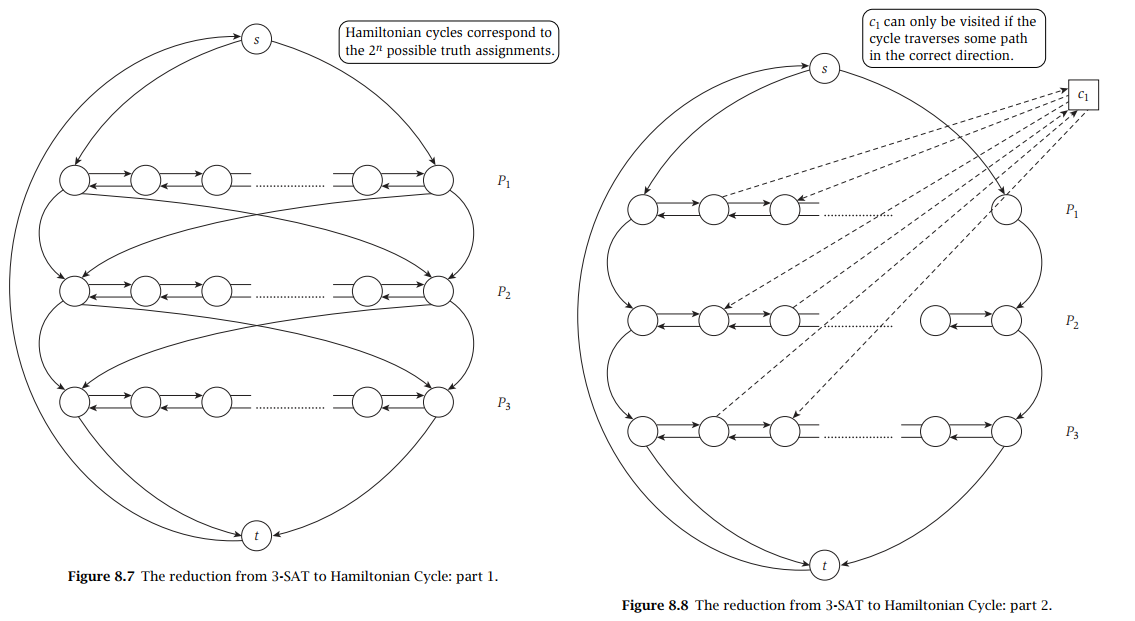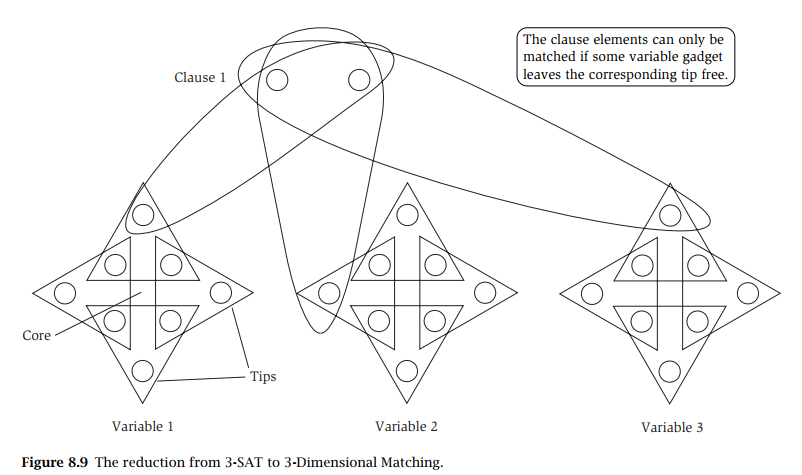Algorithm Design 6
Chapter 4 NP Completeness
4.4 Other Problems in NPC
Intuition : Find problems \(L\in NP\) that \(SAT\le_p L\) .
4.4.1 3-SAT
Description :
Def [ literal ] : For \(\vec x=(x_1,\cdots,x_n)\in \{0,1\}^n\) , literal is an element of \(X=\{x_i|i\in [n]\}\cup\{\bar x_i|i\in [n]\}\) .
Def [ CNF-clause ] : A CNF-clause \(c\) is a formula with form : \[ c=\lor_{j=1}^m a_j \] where \(a_1,\cdots,a_m\) are distinct literals .
Def [ CNF ] : A conjunctive normal formula (CNF) is a formula \(\{0,1\}^n\to \{0,1\}\) with following form : \[ f(\vec x)=\land_{i=1}^k c_i(\vec x) \] where \(c_i(\vec x)\) is a CNF-clause .
Def [ 3-CNF ] : A 3-CNF is a CNF with all clauses having exactly \(3\) literals . \(c_i=a_{i,1}\lor a_{i,2}\lor a_{i,3}\) , where \(a_{i,1},a_{i,2},a_{i,3}\) are distinct literals .
Input : a 3-CNF
Output : Decide whether there exists an assignment for \(\vec x\) such that \(f(\vec x)=1\) .
3-SAT is NPC
Obviously , 3-SAT is NP .
Goal : SAT $_p $ 3-SAT
Given a SAT instance \(I\) , we construct in poly-time a 3-SAT instance \(I'\) , s.t. \(I\in SAT\iff I'\in 3-SAT\) .
Cook reduction : can use oracle poly times
Karp reduction : only use oracle onceOriginally , Cook define NPC by Cook reduction , but almost always Karp reduction is enough (though stronger than Cook's) ,
For each node \(v\in I\) , construct a variable \(x_v\) in \(I'\)
- If \(v=\lnot\) with child \(u\) , we need \(x_v=\overline{x_u}\) , so add to \(I'\) a clause \((x_v\lor x_u)\land (\overline{x_v}\lor\overline{x_u})\) .
- If \(v=\lor\) with children \(u,w\) , we need \(x_v=x_u\lor x_w\) , so add to \(I'\) a clause \((x_v\lor \bar x_u)\land (x_v\lor \bar x_w)\land (\bar x_v\lor x_u\lor x_w)\) .
- If \(v=\land\) with children \(u,v\) , we need \(x_v=x_u\land x_w\) , so add to \(I'\) a clause \((\bar x_v\lor x_u)\land (\bar x_v\lor x_w)\land (x_v\lor \bar x_u\lor \bar x_w)\) .
- If \(v=0/1\) , add to \(I'\) a clause \(\bar x_v\) or \(x_v\) .
Extend each clause into \(3\) literals : \((a\lor b)=(a\lor b\lor c)\land (a\lor b\lor \bar c)\)
Claim : \(I\in SAT\iff I'\in 3-SAT\)
4.4.2 Independent Set ( IS )
Obviously , IS is NP
Goal : 3-SAT \(\le_p\) IS
Construction
Given 3-SAT instance \(I\) , construct an IS instance \(I'=(G,k)\) , s.t. \((G,k)\in\) IS $I$ 3-SAT .
- Each clause \(x_{i,1}\lor x_{i,2}\lor \bar x_{i,3}\) , construct a 3-cycle \((x_{i,1} , x_{i,2} , \bar x_{i,3})\) (finally \(3n\) nodes , \(3n\) edges).
- Then connecting \(x_i\) and \(\bar x_i\) for all \(i\) .
In each triangle , we can choose at most \(1\) node .
Claim : \((G,k)\in\) IS $I$ 3-SAT ( \(k\) is the number of clauses )
Proof :
- If $I$ 3-SAT , then there is a valid assignment
\(\vec x\) . Each clause has at least
one
true, so we choose that literal in the clause , this is an independent set in \(G\) with size \(k\) . - If $(G,k)$ IS , for each literal \(x_i\) (\(\bar x_i\)) chosen , let \(x_i=1\) ( \(x_i=0\) ) . The rest of variables are assigned arbitrarily . This assignment is a valid assignment for \(I\) , so \(I\in\) 3-SAT .
- If $I$ 3-SAT , then there is a valid assignment
\(\vec x\) . Each clause has at least
one
Cor : Vertex Coloring , Set Coloring \(\in\) NPC
4.4.3 Hamiltonian Cycle ( HC )
Description
- Input : A directed/undirected graph
- Output : Decide whether there exists a cycle visiting each vertex exactly once
TSP : weighted , determine the shortest Hamiltonian Cycle
TSP is NP-Hard
HC is NPC
Obviously , HC is NP
Goal : 3-SAT \(\le_p\) HC
Construction
Consider an instance \(I\) for 3-SAT , construct \(G\) , s.t. \(G\in\) HC $I$ 3-SAT .
Suppose \(I\) has \(n\) variables , \(k\) clauses .
\(S,T\in V\) , \((T,S)\in E\)
\(n\) lines (\(P_i\)) : on line \(i\) : \(x_{i,0/1}\in V\) , \(v_{i,j,0/1/2}\in V\) , \(1\le j\le k\) , \((v_{i,j,0},v_{i,j,1}),(v_{i,j,1},v_{i,j,2}),(v_{i,j,2},v_{i,j+1,0})\in E\)
\((x_{i,0},v_{i,1,0}) , (v_{i,k,2},x_{i,1})\in E\)
Between two lines : \((x_{i,0},x_{i+1,0}) , (x_{i,0},x_{i+1},1) , (x_{i,1},x_{i+1,0}),(x_{i,1},x_{i+1,1})\in E\)
\((S,x_{1,0}),(S,x_{1,1}),(x_{n,0},T),(x_{n,1},T)\in E\)
Clause : For example \(c_a=(x_i\lor \bar x_j\lor x_k)\)
\(c_a\in V\) , \((v_{i,a,0},c_a),(c_a,v_{i,a,1})\in E\) , \((v_{j,a,1},c_a),(c_a,v_{j,a,0})\in E\) , \((v_{k,a,0},c_a),(c_a,v_{k,a,1})\in E\)

\(v_{i,j,2}\) for constraining the Hamiltonian cycle be the form \(S\to x_{1,0/1}\to x_{1,1/0}\to \cdots\to x_{n,0/1}\to x_{n,1/0}\to T\to S\) .
Cor : Hamiltonian Cycle / Hamiltonian Path for directed/undirected graph are all NPC .
4.4.4 3-Dimensional Matching ( 3DM)
Description
Def [ 3D graph ] : \(G=(X,Y,Z,E)\) , \(E=\{e=(x_e,y_e,z_e)|x_e\in X,y_e\in Y,z_e\in Z\}\) .
Def [ 3D Matching ] : \(M\subseteq E\) satisfies
- $e_1e_2M $, \(x_{e_1}\neq x_{e_2}\) , \(y_{e_1}\neq y_{e_2}\) , \(z_{e_1}\neq z_{e_2}\)
- \(\bigcup\limits_{e\in M}x_e=X\) , \(\bigcup\limits_{e\in M}y_e=Y\) , \(\bigcup\limits_{e\in M}z_e=Z\).
Input : A 3D graph
Output : Decide whether there is a 3D Matching for this graph.
3DM is NPC
Obviously , 3DM is NP
Goal : 3-SAT \(\le_p\) 3DM
Consider an instance \(I\) for 3-SAT , construct \(G\) , s.t. \(G\in\) 3DM $I$ 3-SAT .
Suppose \(I\) has \(n\) variables , \(k\) clauses .
Construction :
Vertices :
- For each variable \(x_i\) , construct \(A_i=\{a_{i,1},\cdots,a_{i,2k}\}\) , \(B_i=\{b_{i,1},\cdots,b_{i,k}\}\) , \(C_i=\{c_{i,1},\cdots,c_{i,k}\}\) .
- For each clause \(c_i\) , construct \(d_i,e_i\) .
- Cleanup garget : for \(i\)-th garget construct \(y_i,z_i\) .
\(X=\bigcup A_i\) , \(Y=\left(\bigcup B_i \right)\cup \{d_i\}\cup\{y_i\}\) , \(Z=\left(\bigcup C_i \right)\cup \{e_i\}\cup\{z_i\}\)
Hyperedges :
- For each variable \(x_i\) : \(e_{i,2j-1}=(a_{i,2j-1},b_{i,j},c_{i,j})\) , \(e_{i,2j}=(a_{i,2j},b_{i,j+1},c_{i,j})\) . (\(1\le j\le k\) )
- For each clause \(c_t\) : suppose \(c_t=x_i\lor \bar x_j\lor x_k\) : \(e_{t,1}=(a_{i,2t},d_t,e_t)\) , \(e_{t,2}=(a_{j,2t-1},d_t,e_t)\) , \(e_{t,3}=(a_{k,2t},d_t,e_t)\) . (\(1\le t\le k\))
- For each cleanup garget \(g_t\) : \(e_{t,i,j}=(a_{i,j},y_t,z_t)\) . (\(1\le i\le n,1\le j\le 2k\))

Cleanup garget : we need \((n-1)k\) gargets to recycle all free \(a_{i,j}\) ( tips ) .
4.4.5 3-Coloring Problem (3CoL)
Description
Def [ valid coloring ] : Assign each vertex a color , such that no two vertices having same color share an edge
\(\forall e=(u,v)\in E\) , \(c(u)\neq c(v)\) .
Def [ chromatic number ] \(\chi(G)\) :The minimum number of colors that can color the graph validly .
Input : A graph \(G\)
Output : Decide whether \(\chi(G)\le 3\).
2CoL is P , using
dfs4CoL Theorem : Any planar graph can be \(4\)-colored.
Current Proof : need computer assistant ( \(\sim 10^2\) cases to verify )
Open : a proof of 4CoL Theorem without computer assistant ?
3CoL is NPC
Obviously 3CoL is NP .
Goal : 3CoL \(\le_p\) 3-SAT .
Consider an instance \(I\) for 3-SAT , construct \(G\) , s.t. \(G\in\) 3CoL $I$ 3-SAT .
Suppose \(I\) has \(n\) variables , \(k\) clauses .
Construction :
Vertices :
- Special garget : \(T,F,B\) .
- Variable garget : \(v_i\) , \(\bar v_i\) .
- Clause garget : \(6\) vertices for each clause .
Edges :
Special garget : \((T,F),(T,B),(F,B)\)
To ensure \(T,F,B\) having distinct colors
Variable garget : \((B,v_i)\) , \((v_i,\bar v_i)\) , \((B,\bar v_i)\)
To ensure either \(c(v_i)=c(T),c(\bar v_i)=c(F)\) , or \(c(v_i)=c(F),c(\bar v_i)=c(T)\)
Clause garget : Example \(c=(x_i\lor \bar x_j\lor x_k)\)
\((v_i,a),(T,a),(a,b),(T,b)\)
\((\bar v_j,c),(T,c)\)
\((v_k,d),(T,d),(d,e),(F,e)\)
\((f,a),(f,c),(f,e)\)
To ensure that \(f\) can be colored if and only if \(v_i,\bar v_j,v_k\) are not all colored with \(c(F)\).
Otherwise , \(c(v_i)=c(F)\) , so \(c(a)=c(B)\) , so \(c(b)=c(F)\)
\(c(\bar v_j)=c(F)\) , so \(c(c)=c(B)\)
\(c(v_3)=c(F)\) , so \(c(d)=c(B)\) , so \(c(e)=c(T)\)
Then \(f\) cannot be colored

4.4.6 Subset Sum Problem
Description
Input : \(w_1,\cdots,w_n\) , target \(W\) .
Output : determine whether there exists \(S\subseteq [n]\) , s.t. \(\sum_{i\in S}w_i=W\) .
Subset Sum can be solved in \(\mathcal O(nW)\) with DP method
Subset Sum is NPC
Obviously Subset Sum is NP.
\(W\) in the reduction must be exponentially large
Goal : 3DM \(\le_p\) Subset Sum
Construction
For each hyperedge \(e=(x,y,z)\) , construct \(w_e=2^{x-1+|Y|+|Z|}+2^{y-1+|Z|}+2^{z-1}\)
Let \(W=\sum\limits_{x=1}^{|X|}2^{x-1+|Y|+|Z|}+\sum\limits_{y=1}^{|Y|}2^{y-1+|Z|}+\sum\limits_{z=1}^{|Z|}2^{z-1}\)
Problem : carry ( 进位 )
Improved Construction
Let \(b=|E|+1\)
For each hyperedge \(e=(x,y,z)\) , construct \(w_e=b^{x-1+|Y|+|Z|}+b^{y-1+|Z|}+b^{z-1}\)
Let \(W=\sum\limits_{x=1}^{|X|}b^{x-1+|Y|+|Z|}+\sum\limits_{y=1}^{|Y|}b^{y-1+|Z|}+\sum\limits_{z=1}^{|Z|}b^{z-1}\)